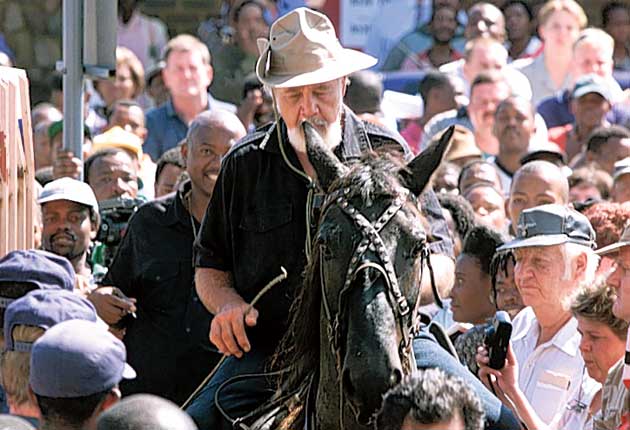Advocate of hatred who became a figure of fun
He never compromised his views, but Eugene Terreblanche's final years were marked by obscurity and absurdity.

It was A measure of Eugene Terreblanche's political ineptitude and racist fervour that he proclaimed victory for his movement and its white supremacist ideals at the moment of its heaviest defeat. Three senior members of his neo-Nazi paramilitary group lay dead on the soil of a fast-emerging post-apartheid South Africa, but, with his trademark zeal, Terreblanche insisted that the Afrikaner Resistance Movement (AWB) had scored a "brilliant victory".
The invasion of the apartheid-era "homeland" of Bophuthatswana by 750 of Terreblanche's group in March 1994, resulting in defeat at the hands of the enclave's black security forces – including one soldier who shot dead three Afrikaner "generals" in front of television cameras – is regarded as the moment that he and his white extremists lost their self-proclaimed "war" against the establishment of black majority rule.
A judicial inquiry into the incident laid blame for the tragedy squarely at the door of Terreblanche and the AWB, stating: "It brought with it the realisation that assaults upon and the killing of blacks will result in retaliation with, in many instances, fatal results. [This] led to the cessation of the militant activities and the demise of the militant right-wing elements in the South African political milieu."
Terreblanche, a former policeman who had set up the AWB as a secret society in a Johannesburg garage in 1973, achieved a rapid ascent as the figurehead of efforts by a fearful white minority to cling on to power in South Africa during the 1980s and 1990s. With fiery – but frequently impenetrable – oratory, he exhorted people to bear arms in the search for a separate Boer state.
With a voice that alternated between menacing whisper and booming fury, the bearded extremist – whose liking for khaki shorts gave him the appearance of a superannuated Boy Scout – warned packed rallies of Afrikaner supporters of an apocalyptic battle to prevent black rule. He said: "We are going to hit them hard, physically and violently. They will be levelled with the earth."
Such tilting at windmills while the ANC leader Nelson Mandela and President F W de Klerk negotiated a new post-apartheid constitution drew many to conclude that Terreblanche was a bullying clown at the head of a red-necked legion paramilitaries marching beneath the red, white and black flag that paid conspicuous tribute to their Nazi forebears. The effect was completed by Terreblanche's fondness for heading protests on the back of one of his horses in the manner of a Hollywood cowboy villain.
But from his base in the depressed Transvaal town of Ventersdorp, Terreblanche and his AWB nonetheless engineered a blood-soaked campaign to spark what it hoped would become a racial civil war.
When President de Klerk came to Ventersdorp in 1991, police were forced to fire on an AWB mob, killing three protesters. Two years later, Terreblanche led the armed storming of the World Trade Centre in Johannesburg where talks on a post-apartheid settlement were taking place.
Even as the first democratic elections in South Africa were going on, the AWB conducted a series of bombings which claimed 21 lives, including an attack on Johannesburg's main airport. As Terreblanche's men withdrew from Bophuthatswana on 11 March 1994, they killed an estimated 100 people.
Ultimately, however, this proselytiser for hate was largely undone by ridicule. From the moment he was filmed falling off his handsome steed at a parade in Pretoria to the British film-maker Nick Broomfield's lampooning documentary, The Leader, His Driver and the Driver's Wife, the menace posed by Terreblanche was slowly defused by his transformation into a national joke. Claims of an affair between Terreblanche and a South African gossip journalist led to a High Court libel trial in London during which the AWB leader was ridiculed for a series of revelations, including his fondness of a pair of ripped green underpants.
In the wake of the murderous Bophuthatswana debacle, the AWB's influence began to wane. What sway Terreblanche, who was granted an amnesty by South Africa's Truth and Reconciliation Commission, continued to exert was nullified by two prison terms for violent assaults on black men, including one on a security guard who was beaten so badly by the AWB leader that he was left brain-damaged.
Terreblanche emerged from prison in 2004 claiming to be a born-again Christian and insisting he had modified his views on race. He settled down to a life of relative obscurity, but the fiery rhetoric was never far away. Last year, as he tried to resurrect the AWB, he told an audience: "Now all true Afrikaners must reach out to each other and fight to the bitter end. Our country is being run by criminals who murder and rob. This land was the best, and they ruined it all. We are being oppressed again. We will rise again."
Subscribe to Independent Premium to bookmark this article
Want to bookmark your favourite articles and stories to read or reference later? Start your Independent Premium subscription today.

Join our commenting forum
Join thought-provoking conversations, follow other Independent readers and see their replies